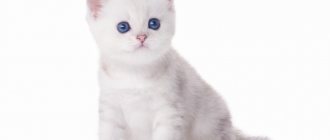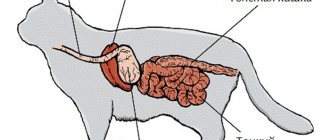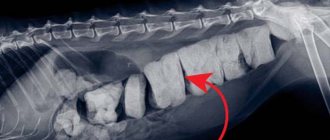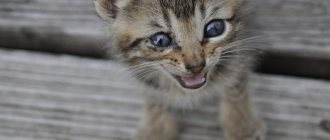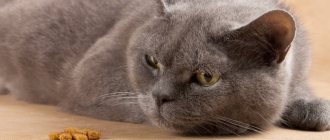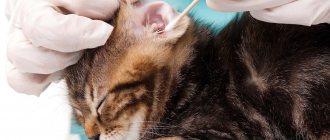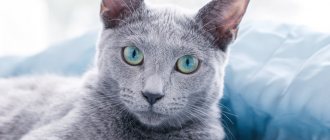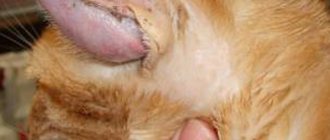A common pathology found in small breed pets is rectal prolapse. This condition is typical for young individuals and pets over 10 years old.
The prolapsed organ looks like a reddened tumor in the anus area. If treatment is not started in a timely manner, the intestine becomes pinched, its cells die, and tissue necrosis begins.
Description of the pathology
Under certain conditions, several layers of intestine exit through the anus.
The size of tissue protrusion can vary from a few millimeters to 2-5 cm.
As soon as the organ comes out through the anus, swelling develops. This prevents reduction and restoration of the physiological position.
Postoperative care
Set up a house or bed for the animal on the floor. It should be soft, comfortable and warm. The animal's chest and abdominal area should not be compressed.
If there is no prohibition from the veterinarian, place heating pads in the house - the cat often freezes after anesthesia.
You can use special heating pads or make them yourself: plastic bottles are filled with hot water and wrapped in rags so that the animal does not get burned.
Wipe your cat's face daily: the area around the eyes, ears and nose. The pet may not have the strength to perform high-quality hygiene procedures.
The postoperative period involves wearing a bandage-diaper. It is important to ensure that the cat does not remove it. If the animal persistently pulls off the diaper and licks the seams, it is recommended to wear a special collar, which limits the pet’s ability to remove the bandage.
Kinds
Depending on the degree of prolapse, the pathology is divided into several types. The anal sphincter weakens for various reasons, and during the process of defecation, a protrusion of a section of the lower intestine occurs.
This is a common illness that occurs due to poor diet or problems with bowel movements.
Partial
With this type of pathology, a slight protrusion of the colon mucosa is observed.
Pathology develops after bowel movement. Incomplete prolapse can resolve on its own without human intervention.
Complete
With this pathology, the veterinarian notes protrusion of the entire rectum.
With complete prolapse without manual reduction or other types of correction, the prognosis is unfavorable. The exposed intestinal mucosa is injured and its tissues die. In advanced conditions, blood poisoning occurs - sepsis . If the pathology is treated with any of the methods shown, the cat can be saved.
Why does the intestine need to be realigned?
After examining the animal, the veterinarian decides to restore the physiological position of the organ.
This is due to the fact that with edema, necrosis of the intestinal wall develops due to strangulation.
At-risk groups
Most often, prolapse develops in a kitten under 6 months of age due to intestinal immaturity. Animals at this age suffer from indigestion.
The pathology can develop in cats after prolonged labor during childbirth, or in animals that constantly eat dry food. Pathology also occurs in older animals suffering from diseases of the genitourinary system.
Synonyms
The pathology is often called rectal prolapse or intestinal protrusion.
What does it look like?
The two most important symptoms:
- painful attempts to empty the intestines, accompanied by restlessness of the pet, meowing, and subsequent attempts to lick under the tail;
- a pink-crimson “bump” 1 cm or more long appears under the tail, which does not disappear anywhere and does not retract.
Cats don't have hemorrhoids! Any protrusion in the anal area should attract the attention of the owner and serve as a reason to take the cat to the veterinary clinic!
If the functions of the sphincter are not impaired, then the prolapsed section of the intestine can be pinched, the blood circulation is blocked, and the risks of its death (ulcers, necrosis) increase.
Degrees of loss:
- I – only with strong attempts, but independent retraction is observed;
- II – after bowel movement, the prolapse does not reduce, but the protrusion is not strong and it is enough to simply push it back with your hands;
- III – prolapse is observed with any strain on the cat, be it the intestines or, for example, the bladder;
- IV – the rectum falls out even at rest, when walking.
Causes of hair loss
There are many factors influencing the development of the disease.
Basically, the provocateurs of prolapse are conditions that require significant stress from the animal during defecation, urination, and during lambing.
Enteritis and endoparasites
As a result of frequent intestinal disorders, irritation of the mucous membrane occurs, weakening of the muscles of the anus, causing prolapse.
Worm infestations are common causes of prolapse in young kittens.
Toxins released by worms cause irritation of the mucous membranes of the large intestine. During defecation, there is a strong tension in the anal sphincter muscles, which causes pathology.
Neoplasms
Oncological diseases also provoke the formation of prolapse. Foreign bodies in the perianal area and trauma can also contribute to this.
Perineal hernia
This pathology is rare in cats. Symptoms of the disease: difficulty defecating, frequent constipation, swelling or swelling in the anus. This is the first thing the animal owner notices. People often come to the clinic when their pet has already started prolapse.
Factors predisposing to the appearance of prolapse
Rectal prolapse occurs in diseases that require the animal to exert effort during defecation, urination, or during childbirth.
Other causes include defects in the intestinal mucosa, impaired coordination of peristaltic movements, and inflammation.
Pathologies in which prolapse develops
Loss does not always occur due to any one reason. As a rule, this is a combination of unfavorable circumstances that contribute to the development of the disease.
Diseases that cause prolapse:
urolithiasis, cystitis;- inflammation or enlargement of the prostate, bladder;
- colitis, proctitis;
- chronic constipation;
- oncology.
These diseases cause the animal to strain during defecation. This increases the pressure in the intestines.
A small part of the rectum exits through the anus, its mucous membrane is turned outward. Sometimes the ligaments that maintain the correct position of the organ weaken, and prolapse does not occur.
Prevention
Most often, problems with the gastrointestinal tract lead to rectal prolapse. To avoid them, it is necessary to provide the cat with a complete and balanced diet, especially for kittens under one year old. Cats can be fed natural food or commercial food.
You may be interested in: Hyperthyroidism in cats: symptoms and treatment.
The pet needs to be given premium and super-premium food. Economy class industrial feeds are poorly balanced and contain various harmful additives. They often lead to digestive disorders and the development of urolithiasis.
Cats that eat only dry food should always have clean drinking water freely available.
A natural diet should consist of the following products:
- Meat (chicken, turkey, lean veal) and offal.
- Cereals.
- Low-fat fermented milk products.
- Vegetables.
- Cats should not be given fish more than once a week. It must be a sea fish from which the bones have been removed.
The following should be completely excluded from the diet:
- sweets (especially dark chocolate, which is poisonous to cats);
- potatoes and legumes;
- fatty pork and smoked meats;
- chicken tubular bones;
- salt and spices;
- milk after the kitten is 4 months old.
It is also necessary to periodically prevent helminth infection. Anthelmintic drugs should be given even to animals that do not go outside, but constantly live at home. Infection can occur through the owner's street clothes.
The drug prescribed by the veterinarian is given to the cat in the morning on an empty stomach. You can feed the animal a couple of hours after this. Preventive deworming should be carried out every 3-4 months. This is especially true for street animals. If, after deworming, worms come out in the feces, the cat should be given the tablet again after 10-12 days.
There should be no freely accessible items that animals can swallow. Cellophane bags, threads, and New Year's rain are especially dangerous.
The vaccination schedule should be monitored. The first vaccinations are given to a kitten at two months of age. An adult animal is vaccinated once a year, regardless of whether the cat has free access to the street or is constantly at home.
You should also pay close attention to the general health of the animal.
Symptoms that indicate that your pet needs to be seen urgently by a doctor:
- frequent constipation or diarrhea;
- frequent vomiting;
- decreased activity;
- increased salivation;
- change in wool quality;
- increased body temperature;
- bad breath;
- restless behavior of an animal for no reason.
Don't ignore your pet's health problems. Most diseases can be completely cured only in the first stages.
Signs of prolapse
The clinical picture of prolapse is characteristic of this disease. It can be compared to hemorrhoids, but it is important to remember that cats do not have them.
Edema, ulceration of the intestine
Upon visual examination, even the owner of the animal without veterinary education observes that the rectum is protruded, swollen, inflamed, turned red, and ulcerations have formed.
In some cases, the “bump” appears only during bowel movements.
Anal discharge
One of the alarming symptoms is bloody and mucous discharge from the cat’s anus. In advanced conditions, the intestine is torn off.
How to prevent rectal prolapse
To reduce the risk of pathology, the following simple rules should be followed:
- carry out deworming treatment regularly and in a timely manner;
- maintain a balance in feeding without causing diarrhea and constipation;
- make sure that the cat does not swallow anything foreign;
- promptly treat gastrointestinal diseases;
- get vaccinated against infectious diseases according to the vaccination schedule (some of them occur with signs of enterocolitis).
Author:
Grinchuk Ekaterina Andreevna veterinarian
Treatment: methods and means
If treatment is started in a timely manner, a complete recovery of the pet is possible without the development of concomitant pathologies and complications.
Conservative treatment
This approach is chosen in the initial stages of the disease, when there are no dead areas and visible injuries on the prolapsed intestine.
In a clinical setting, manual reduction of the prolapsed section of intestine is performed using anesthesia.
The organ is first washed and treated with antiseptics. To prevent recurrent prolapse, the intestine can be sutured to the anus.
Then a purse-string suture is applied for 5 days, while leaving a hole for the passage of feces. Afterwards, therapy is carried out aimed at eliminating the causes that provoked the pathology.
When is the operation performed?
In case of recurrent conditions, surgical intervention is resorted to. The method is indicated in advanced cases when tissue necrosis of the prolapsed section of the intestine has occurred and the organ has become non-viable.
The dead section of intestine is removed under general anesthesia. The surgeon chooses the most effective method. In this case, the Olivekov method is used.
Amputation of a prolapsed section of intestine
This method of surgical treatment is used in advanced cases, when it is impossible to achieve manual reduction of the prolapsed area or tissue death has occurred.
During the operation, part of the animal's intestine is removed under anesthesia, and then healthy tissue is stitched together. After a successful operation, the intestine is placed in its physiological position.
Then a purse-string suture is placed on the anus for several days to prevent recurrent prolapse.
After amputation, the animal is prescribed laxatives.
Colopexy
This is the suturing of the colon to the wall of the abdominal cavity. The purpose of the operation: to create a fusion of the intestinal lining and the abdominal wall. This helps prevent the colon from moving backward.
Indications: recurrent rectal prolapse.
With the correct choice of conservative or surgical intervention, the treatment prognosis is favorable.
Hemorrhoids in cats and cats
Hemorrhoids are varicose veins in the mucous membrane of the lower part of the rectum and anus. Cats, like people, can also suffer from this disease, although much less frequently. This unpleasant disease causes serious concern to the pet, and if the symptoms are ignored, it can develop into severe pathological conditions.
Causes
There is an opinion among many scientists that varicose veins of the rectum are only human. This is associated with upright posture and increased load on the lower body, which is absent from our smaller brothers.
However, this disease is still diagnosed in cats, and the development of the disease may be associated with:
- Violation of blood properties (excessively thick) and changes in vascular tone.
- Obesity – high cholesterol leads to the formation of plaque on the walls of the veins, which can lead to blockage.
- Diabetes mellitus - the walls of blood vessels are negatively affected by increased glucose levels.
- Frequent constipation and poor nutrition (constant feeding of dry food with insufficient fluid intake).
- Lack or, conversely, excessive physical activity.
- Malfunctions of the hormonal system.
Symptoms
Signs of varicose veins of the rectum are similar to those found in humans. It’s quite easy to notice them; the main thing is to carefully monitor your pet’s behavior. The cat begins to walk strangely - it spreads its hind legs wide, tries to go to the toilet less often, and may meow pitifully while sitting in the litter box.
Clinically, hemorrhoids develop from a small compaction, upon palpation of which a dense ball is felt inside.
Then the lump increases in size, protruding beyond the anus in the form of a cone - a hemorrhoid.
If treatment is not started at this stage, the formation will subsequently increase significantly in size and a bleeding ulcer will form on it, due to constant trauma during bowel movements.
- Swelling or redness around the anal ring.
- The appearance of hemorrhoidal lesions and formations.
- Dry stool or prolonged constipation.
- The appearance of drops of blood in the stool.
- Cat restlessness, frequent licking of the perineal area.
It is important to distinguish true hemorrhoids from a disease with similar symptoms - inflammation of the paraanal glands. They have completely different therapies; if diagnosed incorrectly, the course of the disease can significantly worsen.
What is hemorrhoids confused with?
Inflammation of the glands of the paraanal area - in the anal area there are 2 anal glands, which are the source of secretion for marking the territory and for antiseptic action after defecation. When the excretory ducts are blocked, abscesses form, which can rupture and cause bleeding. The main treatment consists of removing pus from the ducts.
Rectal prolapse - occurs when the anal sphincter muscles fail, during difficult childbirth in a cat and frequent diarrhea.
In appearance, the prolapsed intestine resembles an oblong cylinder of bright scarlet or bluish-burgundy color, which swells rapidly from compression by the sphincter muscles.
This pathology requires mandatory surgical treatment and immediate contact with a veterinary clinic.
Diagnostics
When diagnosing hemorrhoids, one should look for the cause of such a disease, which is uncharacteristic for four-legged animals. To do this, you need to check the rate of blood clotting by performing a coagulogram. It is also advisable to determine the level of hormones and blood sugar.
A stool test is performed to check for the presence of parasites and their eggs. I examine the anal area and the condition of the anal glands for differential diagnosis.
Treatment
At the initial - mild stage
In the initial stages of the disease, it is quite possible to get by with home treatment with herbal preparations.
Before starting therapy, it is worth adjusting your pet’s diet - alternate wet and dry food, give plenty of clean water to drink.
Introduce into the menu foods enriched with fiber and dietary fiber - they help form feces and facilitate bowel movements. It is also recommended to give fermented milk products.
The basis of treatment is to ensure proper hygienic care of the anal area. Be sure to wash your cat's anus 2-3 times a day with warm water without soap, using damp non-woven wipes for wiping. After such procedures, lubricate the sphincter area with petroleum jelly or Levomekol mallow.
To relieve inflammation and have an antiseptic effect, suppositories with ichthyol or furazolidone are used. You can also give yarrow infusion in small quantities; it helps relieve inflammation, relieve pain and reduce the formation of blood clots. For the same purposes, you can use candles with ichthyol or Divopride.
When transitioning to a severe form
If the disease has progressed to a severe form with large and ulcerated nodes, the help of a surgeon will be needed. Depending on the characteristics of the process, 2 types of operations are used:
- Using liquid nitrogen, the cones are frozen and then removed. It is minimally invasive and requires only local anesthesia.
- Surgical excision - with the help of instruments, dilated veins and the adjacent mucous membrane are removed.
After operations, it is recommended to limit the cat’s activity and introduce an additional course of multivitamins, as well as use wound healing ointments (Iruksovetin, Ranosan) and drugs to speed up recovery (Tsamax, Gamavit).
Prevention
- Carry out preventive deworming once every six months.
- Monitor proper nutrition and drinking regime. Alternate dry and soft food, include vitamins and minerals and fatty acid complexes in the cat’s diet.
- If you experience prolonged constipation or diarrhea, contact your veterinarian immediately.
- If the cat does not take good care of its hygiene, then periodically clean the anus area with wipes.
- Monitor your pet’s weight; if there are signs of excess weight, increase physical activity and ensure a balanced diet.
Source: https://nld.ru/koshki/bolezni/hirurgicheskie/gemorroy/
Caring for your cat after surgery
During the rehabilitation period, cats are prescribed antibiotics.
After resection of part of the intestine, special anesthetic gels are injected into the anus. This promotes normal bowel movements. To prevent the animal from licking the operated area, it is given special diapers in the form of a bandage.
The pet is provided with peace and warmth; hypothermia should be avoided during this period.
Nutrition as a component of treatment
The food should be gentle, the products should be light, ground, in a mushy or liquid state.
Dry food is not given to cats at this time. The animal is fed often, but in small portions.
Decoding the concept
Rectal prolapse (the second name of the disease) is a relatively unusual pathology in which rectal tissue protrudes from the anus, and in appearance this formation resembles some kind of outlandish “flower”. In a word, when some kind of folded tube protrudes from the anus of an animal, it’s time to sound the alarm: this is probably a prolapse.
The rectum is the part of the large intestine that ends at the anus. Rectal prolapse, as a rule, occurs in kittens that have not yet reached six months of age.
The cause of hair loss usually remains a mystery, but many veterinarians believe that the root cause is still intense helminthic infestation.
A sick animal usually strains very hard with each bowel movement, and the straining is so strong that part of the rectum eventually bulges out.
It is also believed that the causes of rectal prolapse in a cat may be hidden in persistent constipation. If your cat constantly eats exclusively dry food, or he has a predisposition to megacolon, then when defecating, the animal constantly strains and groans strongly. All this contributes to the development of pathological processes in the tissues surrounding the rectum.
In older animals, prolapse is also very likely to develop. In these situations, the underlying cause of tension and possible prolapse is often associated with anal wound or tumors (which are especially common in older cats).
Animals with rectal prolapse can almost always make a full recovery if their owners consult a veterinarian promptly. Even if a small “bump” appears at the site of the anus, nothing good can be expected.
Cats do not get hemorrhoids (!), so any changes in the “posterior regions” are a very alarming symptom. Among the first aid measures, we can recommend wrapping the animal's bottom in a clean cotton cloth moistened with warm boiled water.
This will prevent the animal from licking the prolapsed rectum and protect the organ from injury.
Main symptoms
What are the general symptoms of this pathology? In general, there is nothing complicated here, and even a person far from veterinary medicine can determine the presence of the disease.
So, the most characteristic signs:
- The animal is very heavy, with visible tension and groaning, walking on the tray “at large.”
- You can see a “bump” or a “tube” clearly protruding from the anus. Note that in mild cases the tumor is not always visible. The rectum protrudes only during bowel movements.
- Excessive licking of the anal area and genital area.
But the main symptom, of course, is the presence of a protruded, swollen rectum. In appearance, it looks like a swollen, stretched bubble. The longer the organ is in an external position, the more hyperemic (reddened) and swollen its shell becomes.
Let us remind you once again that constant bulging of a segment of the rectum is characteristic only of severe, advanced cases of prolapse. If something pinkish protrudes from the anus during a bowel movement, take your pet to the vet immediately. This disease is much easier to cure in the earliest stages.
Diagnostics
- The diagnosis of rectal prolapse is made during a medical examination. Rectal prolapse must be differentiated from small bowel prolapse. The latter disease is a much more serious problem.
- To distinguish the two pathologies, you don’t have to resort to any complex diagnostic techniques: just take a medical thermometer, lubricate its tip with sterile Vaseline, and then carefully insert it into the cat’s anus, trying to push a piece of fallen tissue back there.
- If you manage to perform this action without applying significant effort, then with a high degree of probability we can talk about prolapse of a segment of the small intestine. The animal then needs surgery. In the case when this kind of “probe” cannot be inserted far, then it is probably a case of prolapse of the rectum, the tissue of which is much thicker and “coarser”.
- Regardless of the nature of the condition, your veterinarian should try to determine the cause of rectal prolapse in a kitten or older animal.
- A stool analysis must be carried out, which is done to confirm/refute the presence of parasites in the animal’s intestines.
- In older cats, an x-ray or ultrasound examination of the abdominal cavity can be extremely useful, during which a tumor, adhesions, and pathological narrowing of the pelvis can be detected.
Therapeutic approach to treating prolapse
Early initiation of treatment is critical. If the prolapse has occurred recently, and the tissues have not yet had time to die, there is a chance for a successful completion of the matter: the intestine is set back and the tissues around the anus are sutured with a purse-string suture.
The latter is done in order to prevent recurrences of rectal prolapse. It is important to remember that the seam must be loose enough so that the animal does not experience any difficulty during defecation.
Typically, suture material is left in the postoperative wound for 48 hours and then removed.
It is better to avoid surgery, since amputation of the rectum (even part of it) is fraught with complications.
There is a high risk of introducing infectious agents; very often such animals develop the phenomenon of spontaneous defecation.
If the case has already developed to the category of “neglected” before treatment, then the prognosis varies from cautious to unfavorable. Treatment at home is not practiced!
There are no specific recommendations for caring for a cat with prolapse. If he wears a diaper during the postoperative period, simply do not allow the animal to rip it off, scratch it, or lick the postoperative wound. This will probably end badly.
As for dietary feeding, in this case it is necessary to feed the cat light, balanced food. In general, older animals can be given baby formulas enriched with dietary fiber. The latter prevent constipation and reduce the risk of relapse of the pathology.
These mixtures can also be given to small kittens (provided they continue breastfeeding). If the animal has already grown up, then in order to prevent constipation and coprostasis, do not get carried away with cereals: the cat should be given light, easily digestible meat. It is easily digested, and feces do not stagnate in the intestines.
In some cases, after resection of a significant part of the rectum, cats have to inject special anesthetic gels directly into the anus, since otherwise the animal cannot relieve itself normally.
How to prevent prolapse
Prevention of hair loss is based on preventing the development of dangerous diseases that weaken the sphincter muscles.
Worm infestations
This point should be given special attention, since helminths affect cats of any age.
Most intestinal pathologies develop due to parasites. Once a quarter, it is recommended to submit feces for analysis to determine the presence of worm eggs. Afterwards deworming is carried out.
It is necessary to regularly treat your pet for fleas, as they are carriers of certain types of parasites.
Timely treatment of diseases
If you detect any signs of ill health in your cat, you must promptly contact a veterinary clinic.
Advanced diseases of the intestines and genitourinary system often provoke this pathology. Only surgery will help here.
Balanced diet
It is important to choose good food for your pet.
Food should not cause constipation or frequent diarrhea. After consultation with a veterinarian, a cat with digestive problems may be prescribed probiotics and other medications to improve digestion . You should also stop using dry food on an ongoing basis.
Diagnostics
Rectal prolapse is a serious problem that, without timely and proper treatment, can lead to the death of the animal. Even if, after partial prolapse, the intestine retracts itself and falls into place, the animal still needs to be shown to a doctor.
Until the cause of the prolapse is eliminated, the animal’s condition will begin to deteriorate. Soon the loss will be complete.
Immediately after the incident, the protruding intestine must be treated with an antiseptic solution to avoid infection. As a last resort, the fallen part can be washed with clean boiled water.
Afterwards, you need to apply a sterile bandage, put the cat in a carrier and immediately go to the veterinary clinic. If the intestine turns blue or black, you cannot wait a minute - the animal needs urgent help.
A visual examination is required to make a diagnosis. Based on the appearance of the intestine, the doctor will make a conclusion about how long ago the prolapse was. It is also important to understand whether the vessels are pinched or whether there are injuries or ruptures in the intestine.
Depending on the stage at which the pathology is, the doctor will prescribe appropriate treatment. In addition, the doctor must determine the cause of rectal prolapse. It is not easy. The animal will have to undergo a series of tests.
- First of all, you will need to have your stool tested to rule out infection with worms.
- A complete blood count may also shed light on the cause.
- Ultrasound examination, X-ray and colonoscopy will help to exclude diseases of internal organs and the appearance of tumors.
What is the risk of injury?
Rectal prolapse is not a harmless condition for a pet, especially if we are talking about a kitten, in which all processes in the body occur much faster than in an adult.
- If you notice symptoms of hair loss in your animal, you should immediately contact your veterinarian. The matter does not require delay, because the prolapsed appendage, exposed to air and the external environment, dries out, becomes sensitive, the mucous membrane becomes covered with microcracks, into which bacteria can enter and cause inflammation.
- In addition, the intestinal segment compressed by the sphincter swells, its blood circulation is disrupted, and in advanced cases, tissue necrosis may develop.
- If the prolapsed appendage becomes infected, sepsis can occur, which leads to the death of the animal.
- The pain that occurs when a prolapsed intestine becomes infected moves to the abdominal area and can cause depression in the pet’s respiratory activity.
Important! Since cats have a much lower pain threshold than humans, it is not always possible to determine the degree of pain by their behavior. Therefore, when the first signs of the disease appear, it is important to immediately show the animal to a doctor.
Mortality from painful shock as a result of prolapse of the appendage of the rectum if assistance is not provided to the cat in a timely manner is very high.
Useful video
For information on surgery for rectal prolapse in a cat, watch this video:
Similar articles
- The cat has bloody feces: what does it mean, why did it appear...
There are many pathologies in cats and cats. If a cat has bloody stool, what does this mean? Why does this happen and what to do if there is blood in the stool? ... Rectal cancer is uncommon in cats, however, this should be excluded... Read more - What to do if your cat is constipated?
Often occurs due to injuries to the intestines and ligaments that support them, as well as malignant neoplasms in the rectal area. Don't throw away stressful situations either. Cats often violate the regularity of the act... Read more
- Uterine prolapse in a cat: reasons why it happened...
A cat has a prolapsed uterus: what to do? Among postpartum complications in pets, uterine prolapse in cats is not the least important. ... When manipulating, it is important not to pinch the bladder and rectum. Read more
- How to give an enema to a cat correctly, is it possible to perform...
The cause of a pet's blindness is cataracts in cats: what to do and how... A well-fed cat is not a joy, but a problem... The purpose of the procedure is to cleanse the contents of the large intestine and eliminate the accumulation of feces from the rectum. Read more
- Tail fracture in cats and cats: symptoms and treatment
Tail injury or fracture in a cat: symptoms, owner actions and prevention. ... The consequence of injury may be disruption of spontaneous emptying of the bladder and rectum. Read more
What can you do at home?
It is allowed to independently eliminate rectal prolapse in a cat only in the first two stages. These situations usually do not require surgical intervention - the intestine does not fall out completely and retracts itself, or quite carefully, without much effort, you can set it yourself. It is enough just to gently press on the protrusion after washing with any inert antiseptic - for example, chlorhexidine or furacillin. If pharmaceutical solutions are not available, boiled water or a light pink solution of manganese will do. The protrusion should not exceed 1 cm.
If you have never encountered such a pathology and are not sure of the correctness of your actions, we strongly recommend that you immediately take your pet to a veterinary clinic without any attempts at intervention!
If the prolapse is significant, there are signs of swelling and darkening of the prolapsed area of the rectum (strangulation), then the owners need to wash it with boiled water or chlorhexidine, wrap it in a damp, possibly sterile gauze to reduce the risk of injury, and take the cat to the surgeon as soon as possible !
